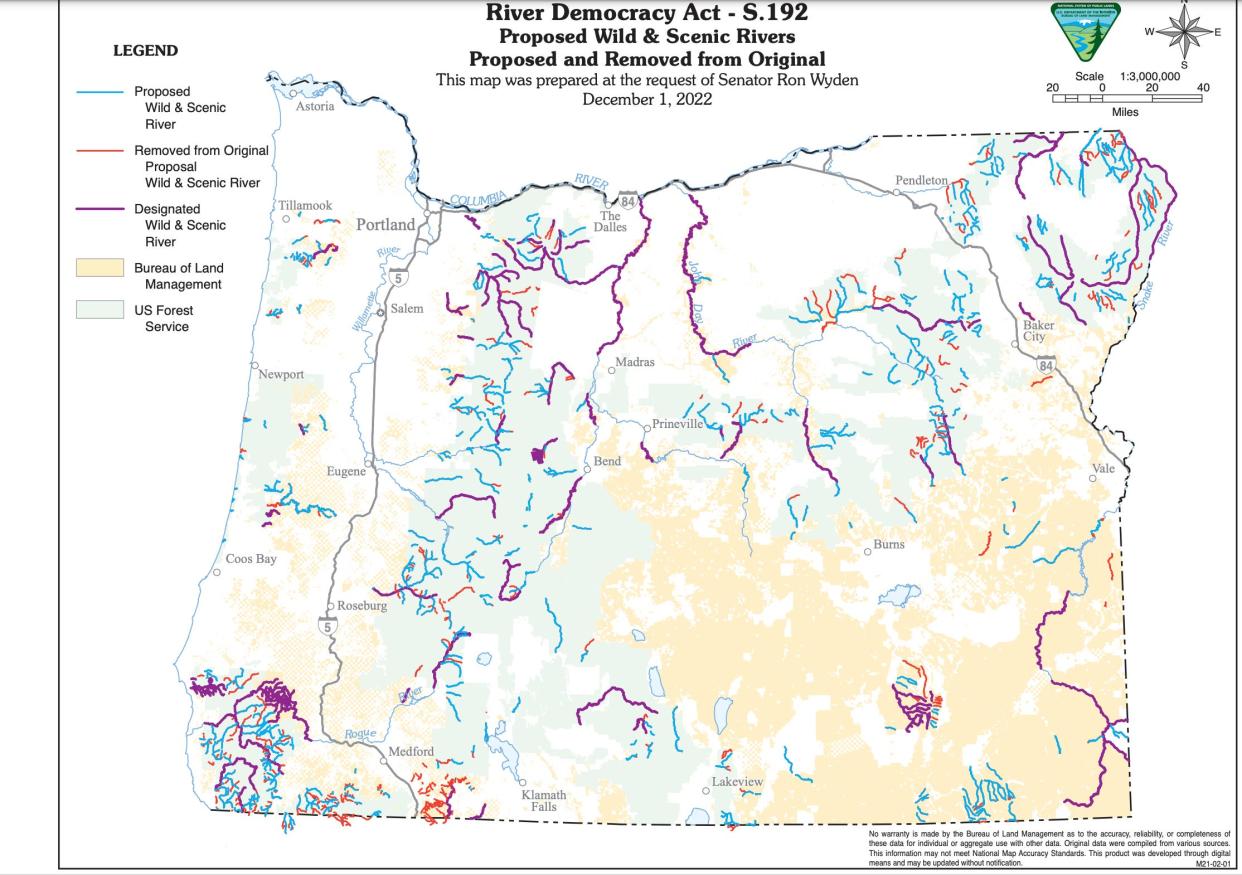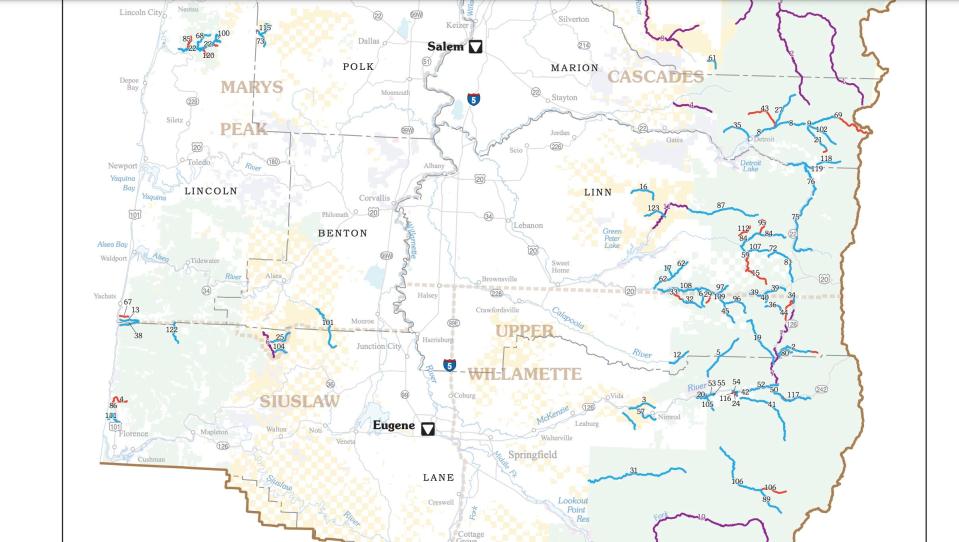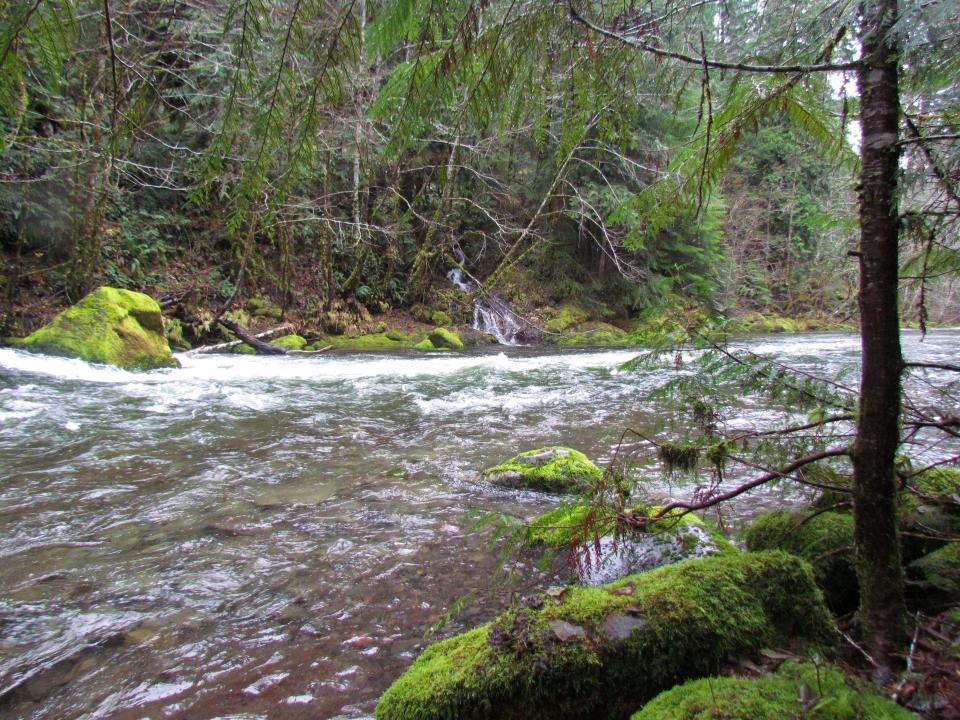Wyden, Merkley introduce scaled back version of River Democracy Act

- Oops!Something went wrong.Please try again later.
- Oops!Something went wrong.Please try again later.
U.S. Sen. Ron Wyden and U.S. Sen. Jeff Merkley, both Oregon Democrats, announced a scaled back version of the River Democracy Act on Tuesday in a move that would apply higher environmental rules to waterways across the state.
The original legislation sought to protect 4,700 miles of Oregon rivers and creeks under the Wild and Scenic Rivers Act, which limits development such as logging and mining within a half-mile buffer on both sides of the stream.
The latest version of the bill scales back the number of river miles protected to 3,215 miles, according to a news release from Wyden and Merkley.
In maps released with the proposed legislation, the streams that have been removed are marked in red while those included in the updated legislation are in blue.
The number of streams and river segments included is vast but only includes waterways on federal public lands and not on private or state lands.
Outside Salem, for example, the bill includes segments of the North Santiam River, French Creek near Detroit and the North Fork Breitenbush River, among others.
Outside Eugene, it includes segments of the McKenzie River and South Fork McKenzie, Bear Creek near Vida and the South Fork Alsea west of Monroe, along with others.

Critics of the first bill said the original list of waterways included obscure streams that barely had running water in the summer and shouldn’t qualify for protection from a law aimed at protecting rivers with “outstanding natural, cultural, and recreational values in a free-flowing condition.”
“This fresh bill provides a fresh start that builds on the progress already made to protect Oregon’s waterways, reduce wildfire dangers, improve drinking water and expand recreation opportunities that support rural jobs and economies,” Wyden said.
The legislation originated when Wyden asked Oregonians to nominate rivers that should have added protections. In the news release, he said he’s gradually fine-tuned those recommendations and the latest bill is the most recent winnowing down.
Wildfire fight
Among the bill's primary opponents has been U.S. Rep. Cliff Bentz, an Oregon Republican who raised concerns that the legislation would place new bureaucracy on areas already at risk of wildfire, thereby preventing the treatments necessary to protect watersheds and communities.
"If passed, this bill would label some 4,700 miles of Oregon rivers, creeks, and streams as 'Wild and Scenic,' although a more appropriate phrase would be: 'just waiting to be burned and ruined,'" Bentz said.
Wyden did say, specifically, that efforts to reduce wildfire danger within the quarter-mile buffer along the streams could continue under the River Democracy Act.
He cited testimony from Jennifer Eberlien, National Forest System Associate Deputy Chief at the U.S. Forest Service, who said the bill gives federal agencies the flexibility to mitigate fire risks, allow for continued livestock grazing, respond to wildfires and help restore watersheds and infrastructure should a fire strike.
Even so, some were deeply skeptical.
“We have many cases where the Wild and Scenic designation had a chilling effect on land management,” said Nick Smith, spokesman for the American Forest Resource Council, a trade group that advocates for more active logging and forest management on federal lands. "In addition to management restrictions it also directs agencies to conduct exhaustive plans that shift time and resources away from urgent priorities … like mitigating wildfires.
"Two years later bill sponsors and supporters still haven’t answered some fundamental questions, like what exactly does this bill protect these segments from, and how?"
Oregon rivers fuel outdoor recreation economy

Oregon currently has 2,173 miles designated in the Wild and Scenic Rivers system out of the state’s 110,994 miles of rivers and streams.
Wyden and Merkley said the state’s rivers and creeks fuel outdoor recreation in Oregon, generating 224,000 jobs and $15.6 billion in consumer spending, according to a 2021 outdoor recreation impact study.
“Oregon’s rivers and streams are some of the most special natural treasures our state has to offer, and have always been integral to the health and vitality of our communities and rural economies,” Merkley said. “By expanding Wild and Scenic designations, we can protect the health of these delicate ecosystems and high-quality water resources, all while increasing wildfire resilience and bolstering our recreation economy.”
The news release cited multiple farmers, guides and business owners who said the legislation would help keep Oregon water clean for recreation, drinking and wildlife.
If passed, according to the news release, the act would do a few things, including:
Designates approximately 3,215 miles of rivers in all corners of Oregon as Wild and Scenic Rivers to expand recreation access and boost local economies, protect drinking water for families, reduce wildfire threats, and sustain endangered fish and wildlife species.
2. Requires federal land managers to assess wildfire risks in Wild and Scenic River corridors, implement a plan to reduce wildfire risks to homes and businesses near Wild and Scenic Rivers, assist local governments to mitigate wildfire risks and restore water quality should a fire strike near a Wild and Scenic River.
3. Encourages federal land managers to develop river management plans in collaboration with Native American tribes and ensures Native American tribes have a voice in how rivers are managed.
4. Ensures that only federal lands are affected by Wild and Scenic designations, while protecting private property rights, water rights and existing permits and rights of way on federal lands.
Environmental groups said that while they disagreed with the bill being scaled back, they supported it going forward.
“Every river and waterway included in the original bill is special, important, and deserving of protection. For streams not included in the revised bill, we know those who originally nominated them will be disappointed and that is understandable,” said Erik Fernandez, wilderness program manager for Oregon Wild. “However, the River Democracy Act remains a historic conservation opportunity to protect our drinking water, fish and wildlife habitat, and recreation opportunities.”
Zach Urness has been an outdoors reporter in Oregon for 15 years and is host of the Explore Oregon Podcast. To support his work, subscribe to the Statesman Journal. Urness is the author of “Best Hikes with Kids: Oregon” and “Hiking Southern Oregon.” He can be reached at zurness@StatesmanJournal.com or 503-399-6801. Find him on Twitter at @ZachsORoutdoors.
This article originally appeared on Salem Statesman Journal: Oregon senators y introduce scaled back version of River Democracy Act

